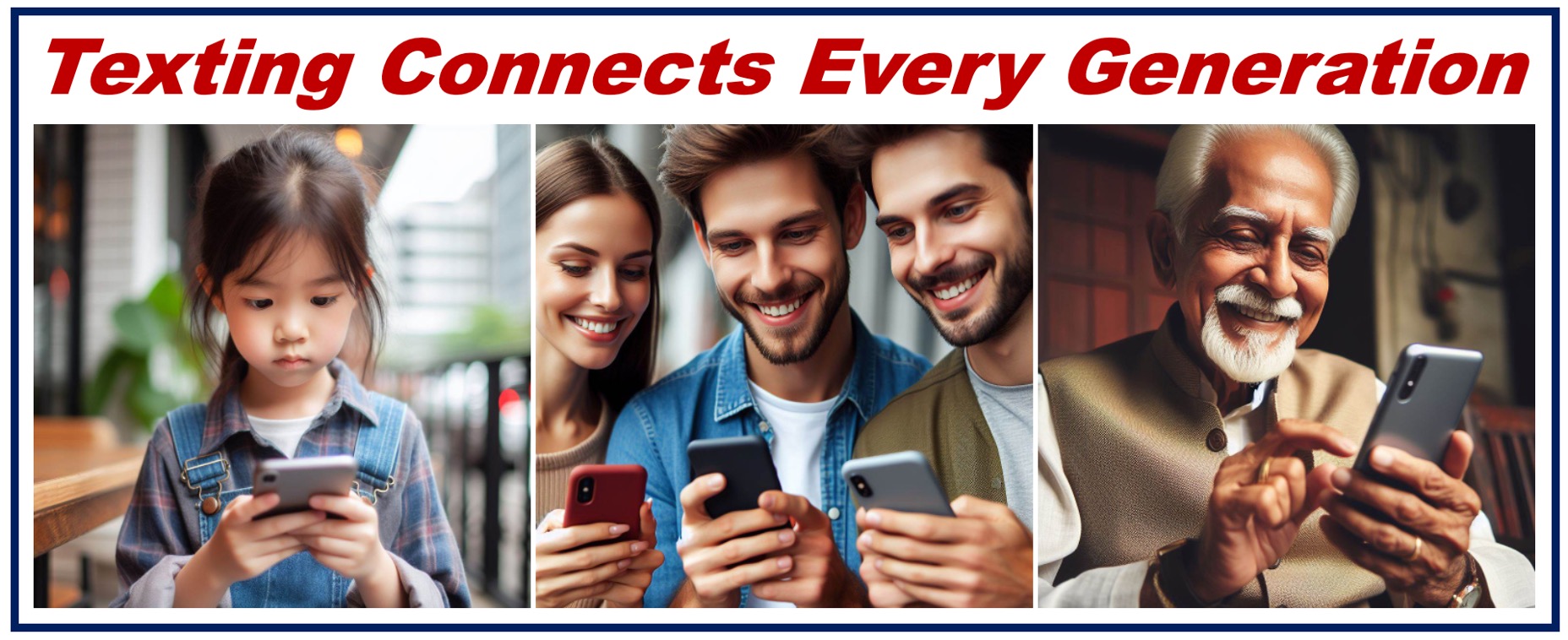The word Text has a long-established and a modern definition. For centuries, the term has meant an extract, passage, or body of writing, either handwritten or printed. The modern form refers to short messages that people send and receive on their cell phones. Texting is the activity of sending such messages.
This article focuses on the modern meaning of the term. This can take the form of a verb or a noun.
Texting has also evolved into a platform for digital storytelling, where narratives are constructed and shared through a series of text messages.
 Texting is a quick and easy method of communication. Image: Kev Costello on Unsplash.
Texting is a quick and easy method of communication. Image: Kev Costello on Unsplash.
Merriam Webster define the verb to text as “to send a text message from one cell phone to another,” or “to communicate by text messaging.” The noun form refers to the message itself, as in “he sent me a text.”
There is also an adjective form, as in “text message” or “text editor”. The latter is a computer program that carries out basic word processing. Notepad, for example, is a simple text editor that Microsoft include with their Windows operating systems.
How texting has evolved
Texting began in the 1980s, with the development of Short Messaging Service (SMS) for cell phones.
Using SMS, cell phone users can text up to 160 alphanumeric characters in a message. If the message exceeds this limit, it breaks up into separate texts.
Nowadays, application programs – or apps – like Facebook Messenger, SnapChat, and WhatsApp also allow users to text. An advantage that these social messaging apps have over SMS is that they use encryption. Without encryption, messaging services can read messages, and so can anyone who intercepts them.
The multiplicity of digital platforms that use texting has led to increased sophistication among users.
For instance, a 2010 Nokia study found that texters with many contacts often carry on several conversations at the same time. It also showed that such users often employ text messaging to switch between a variety of communication services.

Texting as a marketing tool
Businesses are increasingly making use of text messages as marketing tools. Research suggests that SMS open rates are 90% and higher around the world. This compares very favorably with open rates for marketing emails, which sit at around the 20% mark.
Digital marketing advisers, however, suggest that it is not a case of whether SMS is more effective than email, but of making the best of both. Each method has its place. Campaign Monitor, for instance, suggest that SMS texts can be useful for:
- Coming straight to the point with meaningful content
- Sending out coupons and deals
- Keeping customers informed
- Giving quick access to important information
- Sending personal notifications, account updates, and personal alerts
- Informing customers who do not wish to use apps or websites
Texting has become instrumental in healthcare, enabling quick patient-provider communication and timely health updates.
Other uses of text messaging
Government and business organizations also send text messages for purposes other than marketing. The channel offers a fast way to communicate directly with individuals. The following list, while not exhaustive, indicates the wide range of applications:
- Sending weather hazard alerts
- Circulating AMBER alerts about missing children
- Authenticating purchases with one-time passcodes
- Confirming appointments
- Notifying recipients about parcel deliveries
- Informing online shoppers when orders are ready to collect
Text – vocabulary and concepts
There are many words and compound phrases related to texts and texting. Let’s have a look at some of them, their meanings, and how we can use them in a sentence:
-
Text Alert
A notification received via text message, often used for reminders or alerts.
Example: “She received a text alert about her upcoming dentist appointment.”
-
Text Plan
A mobile phone service option that includes a specified number of text messages.
Example: “My mobile carrier offers a variety of text plans to accommodate different levels of usage.”
-
Text Thread
A series of text messages exchanged between two or more users, maintaining a continuous conversation.
Example: “Looking through the text thread, they were able to track the entire conversation history.”
-
Text Update
A brief informational message sent via text, often used to provide timely news or status updates.
Example: “The school sends out text updates to parents about any schedule changes.”
-
Text Conversation
An exchange of text messages between individuals similar to a spoken conversation.
Example: “Their text conversation went on for hours as they discussed the details of the event.”
-
Text Language
The shorthand and abbreviations commonly used in text messages to convey messages quickly.
Example: “He found it hard to understand the text language used by his teenage children; ‘BRB’ and ‘LOL’ were completely new to him.”
Derivatives of of the word “text”
In the world of mobile phones, there are many derivatives of the word “text.” Here are some below:
-
Texting (verb)
The act of composing and sending a text message via a mobile phone.
Example: “She spends a lot of time texting her friends about weekend plans.”
-
Texted (verb, past tense)
The past tense of “text,” indicating the act of having sent a text message.
Example: “He texted me yesterday to confirm the meeting time.”
-
Texter (noun)
A person who sends text messages.}
Example: “As a prolific texter, she quickly replies to all messages she receives.”
-
Textable (adjective)
Capable of being sent or received as a text message.
Example: “My new phone number is textable, so feel free to message me.”
-
Textually (adverb)
Pertaining to or by means of texting.
Example: “They communicated textually rather than through email for quicker responses.”
-
Texting (noun)
The activity or practice of sending text messages.
Example: “Texting has become a common form of communication among teenagers.”
Educational Video – What is Text and Texting?
This interesting video, from our sister channel on YouTube – Marketing Business Network, explains what ‘Text and Texting‘ are using simple and easy-to-understand language and examples.
